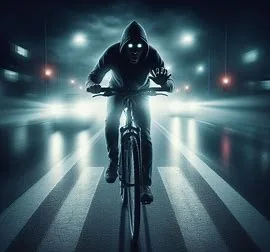Riding a bike at night without lights is generally a bad idea that increases your risk of both collision and legal consequences and jeopardizes your own safety. We recently authored a post on how to best prepare for riding in the dark that introduced the importance of adequate lighting. Here we’ll go a bit further and highlight some major consequences of not having adequate lighting.
Increased Collision Risk
Riding a bike without lights significantly reduces visibility for both the cyclist and other road users, obviously. Without proper lighting, it becomes challenging for motorists and pedestrians to see the cyclist in low-light conditions, increasing the risk of collisions. This danger is most pronounced at intersections, which are generally a danger spot for cyclists even without risks from inadequate lighting.
Legal Consequences
We’ll dive into this one more specifically in another post but a quick summary for now. Many jurisdictions have regulations requiring bikes to be equipped with lights when ridden at night. Riding without proper lighting not only endangers lives but also exposes cyclists to legal consequences. Law enforcement may issue citations or fines for failure to comply with safety regulations. These penalties are designed to promote responsible and safe cycling practices, emphasizing the importance of visibility during nighttime rides. Lots of people think this is a rare occurrence and while it is, I’ve known several folks firsthand or through others that were spoken to by law enforcement while cycling.
Compromised Personal Safety
Put simply, inadequate lighting endangers yourself. Without proper illumination, a cyclist may not be able to identify obstacles, road hazards, or changes in terrain, leading to an increased risk of accidents. Additionally, riding without lights makes it difficult for others, such as pedestrians or fellow cyclists, to anticipate the cyclist’s movements, creating an environment ripe for collisions and accidents. This is all assuming the roads are not icy, another risk in the dark of winter.
Impaired Decision-Making by Other Road Users
When cyclists lack proper lighting, it can lead to confusion and impaired decision-making among other road users. Motorists may find it challenging to judge the speed and distance of a poorly visible cyclist, leading to unpredictable reactions and potential accidents. Its possible a motorist may not even see you at all. This lack of predictability can create a hazardous situation on the road, as drivers may struggle to respond appropriately to the presence of a cyclist without lights.
Negative Impact on The Cycling Community
Irresponsible cycling practices, such as riding without lights at night, contribute to a negative perception of cyclists as a whole. We all suffer when other road users can point to an obvious wrong and say “see, look what the cyclist did”. Instances of poor visibility and safety negligence can foster resentment from other road users, potentially leading to increased tensions between cyclists and motorists. These sentiments can hinder efforts to promote cycling as a sustainable and safe mode of transportation, undermining the broader cycling community’s goals and advocacy efforts.
Conclusion
Riding a bike at night without lights not only poses immediate dangers to the cyclist but also has broader consequences, including legal ramifications, compromised personal safety, and negative impacts on the perception of the cycling community. It is crucial for cyclists to prioritize safety by adhering to regulations and using proper lighting equipment to enhance visibility during nighttime rides.


